‘The Stone Sentinel’
In June 2012 I was due to climb Mt McKinley in Alaska as I had already paid the deposit. When it came time to preparation, I realised I was not physically or mentally ready for this expedition and still a little jaded from my terrible performance on Kilimanjaro. I managed to move the Mt McKinley expedition to June 2013 and spent the rest of the year trying to get into shape. By around October 2012, the weight of the idea of a three week expedition to the highest point of North America in the frozen wilderness of Alaska was bearing down on me and realised that the best way to prepare for McKinley would be to climb another mountain. I booked up the January Aconcagua expedition in Argentina at the end of October 2012 and had only a few months to prepare.
Most of my training for Aconcagua was going up 23 floors in my 80m high apartment tower with a 30kg backpack. I would repeat this 13 times to achieve a 1000m ascent. I did this a few times a week plus general fitness.
I flew from Barcelona, Spain to Mendoza, Argentina via Buenas Aires. Upon arrival in Mendoza I checked into the hotel and met the IMG (International Mountain Guides) team and the rest of the clients. Our lead Guide Mike Hamill checked our equipment and ran us through the itinerary.
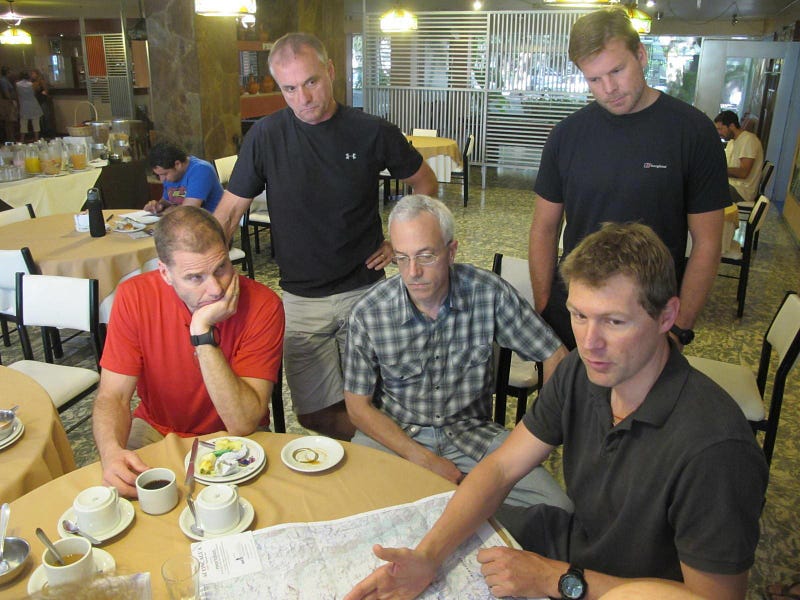



We spent the next day walking around Mendoza stocking up on any needed gear and enjoyed some amazing Argentinian steaks and red wine before leaving early the next morning for a small town called Penitentes, 3 hours away by bus. This is where we would start our expedition to the highest point of South America.
We had a good team of people and after loading up the Pack Mules with gear we didn’t need until Base Camp, the 12 of us spent three days trekking along the river bed towards Mt Aconcagua. We set up camp in lush green valleys and ate flame grilled Argentinian steaks and red wine which was carried in by our Gaucho escorts and their pack mules.

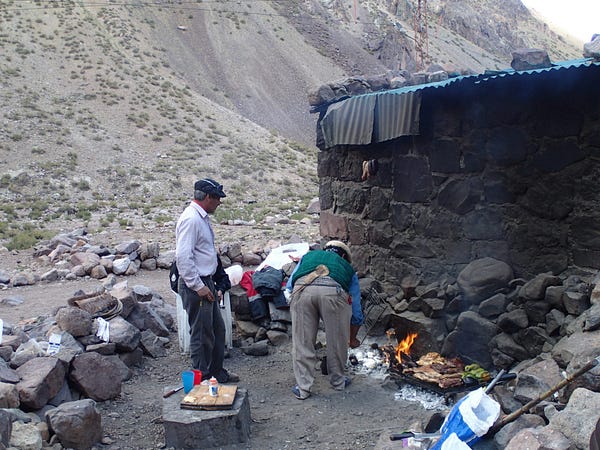



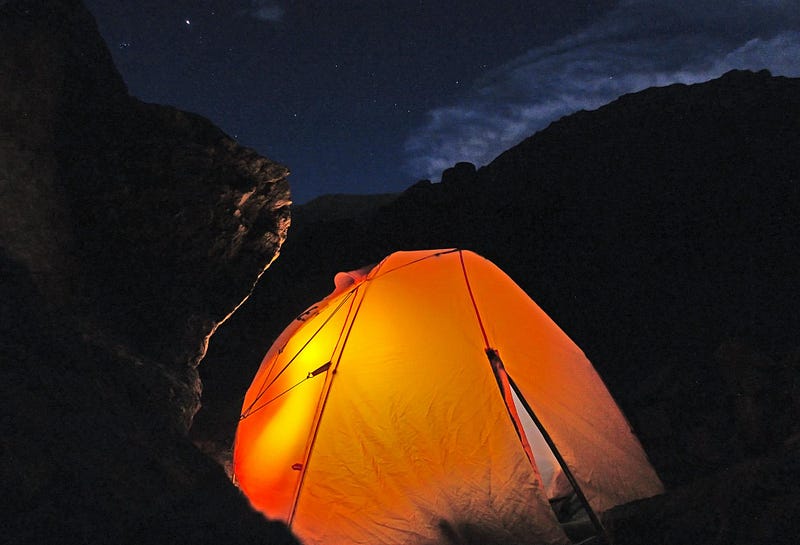
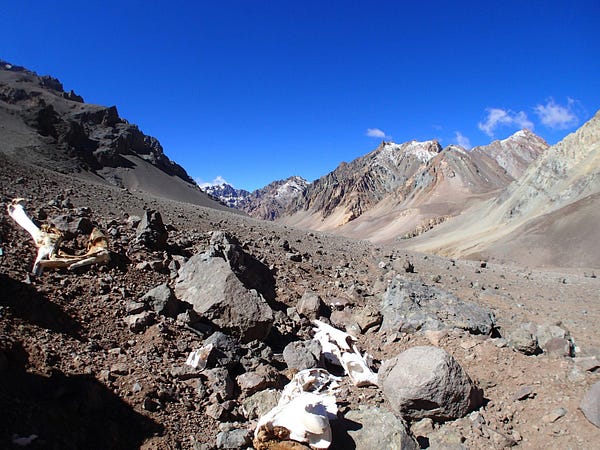

By the afternoon of day three we had arrived at Aconcagua Base Camp (Plaza Argentina) at 4200m.
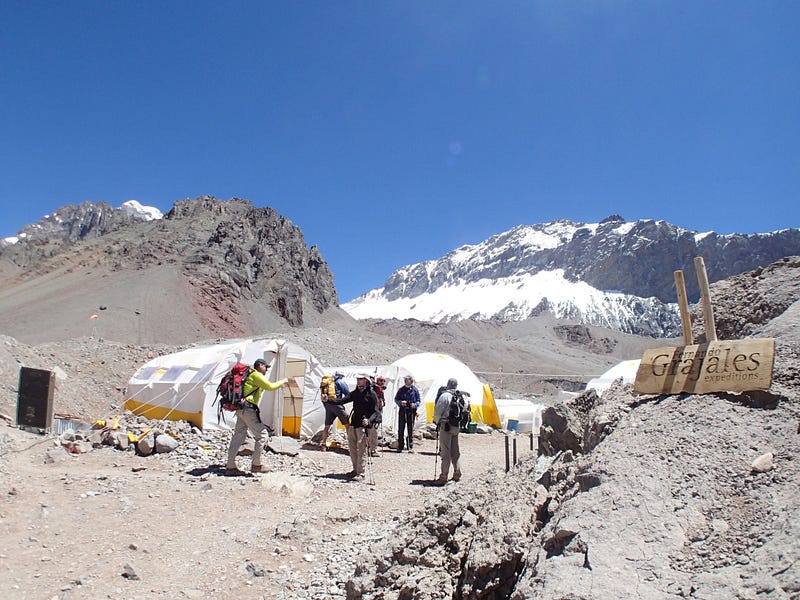
We spent a couple of days here getting ready for what was ahead. The weather had been divine the whole time which meant the summit of the ‘Stone Sentinel’ was looking down on us every moment.

I started to feel some light headedness and headaches in this camp so along with most other people on the team I started to take a small dosage of Diamox each evening to help alleviate some of the symptoms.
We all had our blood oxygen levels and general health checked at the medical tent in Base Camp and then after restoring our energy on amazing food (for a camp-site) we started the process of carry/move up the mountain.
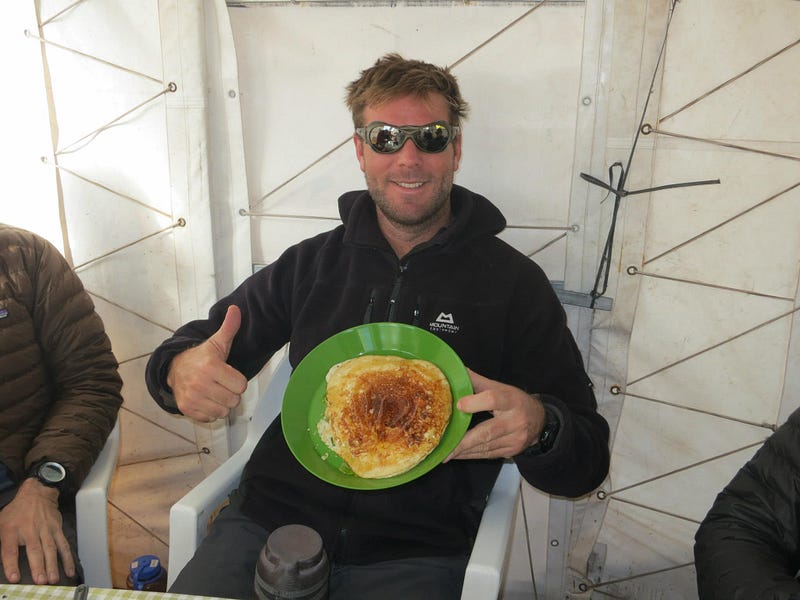
This was the point where we said goodbye to the pack mules and had to carry everything we needed for the expedition to the top and back down the other side. The process of carry/move involves maxing out our 105 litre packs with anything we don’t need that night and climb up carrying said gear to the next camp site where we empty our packs and bury it under rocks (so the ravens don’t get to it). We then scale back down to where we started. The next day we would pack up our remaining gear including tents and poles, camp fuel, more food, and our every day items and then ‘move’ back up to the next camp.
These days were tough! The packs were incredibly heavy and not only were they stuffed full but also had bits and pieces clipped, tied and hanging off the sides which frequently made balancing difficult as things swung around.
We continued this process from Base Camp (4200m) to High Camp 1 (4800m), then to High Camp 2 (5400m) and finally up to High Camp 3 (6000m).

The day we moved from High Camp 2 to High Camp 3 I broke for the first time. I was slow to start that day, once I got going I was behind the group by at least 10 minutes. My pack straps were constantly breaking loose which went from a minor annoyance to a soul destroying, morale sapping hell. It felt like I was never going to get up there and I was sure that I was going to be the first to call it quits on my summit attempt. I was ashamed and embarrassed. In reality it was all in my head and the other guys didn’t even notice.

After a slow painful climb breaking through at least 3 walls and receiving some encouraging pep talks and patience from one of our guides Josh, I made it up to High Camp 3 and threw my pack onto the ground in absolute disgust. I couldn’t wait to get it off my back! After burying our gear we had a rest, ate food, drank water and then on our descent took advantage of slightly melted snow and more or less ran back down the soft snowy slope. Within a couple of hours we were back at High Camp 2 where I hid in the safety of my orange sleeping bag in my orange tent to try and get my head back in the game.

The next day we packed up High Camp 2 and moved back up to 3.
Once we were at High Camp 3 we knew the next objective was the summit. We planned to go around 2am the next morning. That night we ate what we could (you completely lose your appetite at altitude) and tried to get some rest. After a couple of hours I was woken by the screaming wind outside. The tent was violently shaking around and I honestly thought it was going to be ripped off the little plateau we were perched on with us in it!
After a while everybody was awake and I heard Mike our lead guide on the radio outside his tent in the freezing howling darkness. With his 23 summits of Aconcagua, he knew this weather well and decided that despite the apparent blizzard attempting to blow us off the mountain, that we would make our summit attempt a little earlier than planned.
Once again I was concious how fast everybody was getting ready and felt like I was slowing again. My fingers were frozen and I couldn’t even get my crampons on my boots. I was already starting the day feeling useless. Paul who was in another tent was nice enough to help my put my crampons on before we all set out in the icy dark winds.
The morning went well. One of the benefits of climbing through the night is that you can’t see what progress your making. You just put your head down, focus on the tiny bit of light in front of you from your head torch and keep moving.
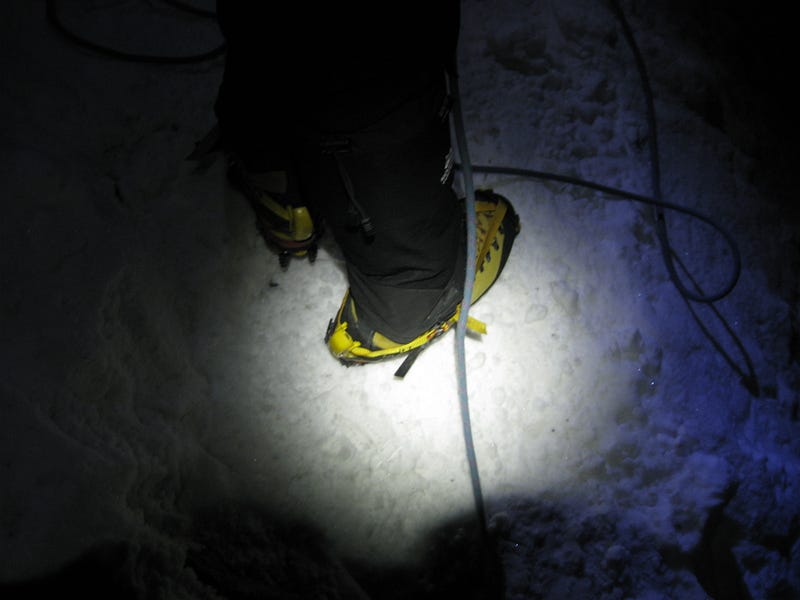
By the time the sun had risen we had ascended a fair way, the winds had died down and the sun was beginning to warm us. We took our first big break at a little hut called Independencia. A clients body from another outfit had been left in that hut for a couple of days only a week earlier, another victim of a rushed ascent.

Despite the spectre hanging over that hut, morale was high and we all felt good. We replenished ourselves with energy snacks and water, sorted out our layers for the next part of the journey and pressed on in two different groups. I was at the back of the first group.
We ascended a small hill and then were presented with a huge wide vista across a massive slope which dropped all the way down 2000m to the base camp on the other side of the mountain. We were to cross this traverse. It looked relatively easy as the path cut horizontally across with a slight incline. I couldn’t have been more wrong.
The winds blowing up this massive slope were maybe 70 km/h and at temperatures well below zero this led to a skin burning wind which could cause frostbite in minutes. I had to cover any exposed skin and as my head system (of balaclavas, buffs, goggles, warm hat…etc) was not ‘dialled in’ properly due to me never being in such conditions, I found that I was suffocating every time I covered my skin. I couldn’t get enough air through the material. It led to a game of face covered to stop frost bite to face uncovered to be able to breathe. This went on for what seemed like eternity and once again I was slowing way behind the first group with the second group nowhere in sight, I was becoming distressed and couldn’t get enough of the thin air. The freezing winds blowing into my lungs then ignited an asthma attack which removed any hopes of getting the tiny bits of oxygen I was desperately trying to suck in. I was getting dizzy with worsening tunnel vision, I’d forgotten about the rest of the team, where I was or what I was even trying to do. There was a moment of calm where it was just me in the silence of my own mind. I wont say my life flashed before my eyes but suddenly all my thoughts were of Alejandra, my family and friends and how stupid and selfish I was to leave them behind. I fell to my knees and don’t remember what happened next.

My next memory is crunched in a ball out of the wind behind the one large rock on the traverse. I was breathing. The light was coming back in and I was starting to absorb where I was and what I was doing. Off in the distance I could see the rest of the guys in the first team. I got my mind back in focus, sorted out my head system, backpack, gloves and layers and when I finally felt confident I stepped back out into the ripping wind.

It was a very slow trudge to the end of the traverse taking 10 second breaks to breathe every two steps. The rest of the team were crouched in a cave like rock formation adding their last layers of clothing and forcing down their energy gels, snacks and water.
I stumbled into the cave and threw myself onto the ground. I knew I was lucky to have made it this far and knew the next part of the climb up to the summit was not an option. Just as I started sifting through my pack for water, the other guys were packed up ready to leave. I wasn’t going with them. I overheard Mike Hamill telling the guys what he had consumed “at least 300 calories and a lot of water” before they headed up.
Mikes comment was repeating in my mind. I pulled out my food and forced down around 400 calories of energy gel, chocolate and nuts and then drank as much water as my stomach could hold. I waited a while and still couldn’t see the second group anywhere on the traverse. After about 20 minutes the food had restored my energy levels and I was feeling pretty replenished. I decided to add my extra layers, throw on my pack and go catchup with my friends in group one who were powering up to the summit plateau.
I had a massive surge of energy, felt power in my legs and back and with the help of a breathing technique called ‘Pressure breathing’ I stormed up the steep rocky ‘Canaleta’ with confidence and a new found power. Within 20 minutes I had caught up some of the guys and even overtook a few, loudly pressure breathing with every step. I finally met Paul again who was taking a break before his last push to the summit. We took a couple of photos for each other, he packed up his things and raced up out of sight. I was amazed at his climbing speed not to mention another guy Steve who was leading the pack the whole time.

I finished my last break, downed a bit more water, threw my pack on and with the approaching thick clouds, I made my final push up to the summit.
When I finally took the last step up onto the summit plateau, I was greeted by Mike who gave me a big pat on the back and helped me remove my pack. I stumbled over to the frozen cross bolted to the highest rock in South America where my mates from the first team were taking photos and celebrating.
I summited Mt Aconcagua (6962m— the highest point of South America and the highest mountain outside of Asia) at 14:00 on the 10th of February 2013.





Our time on the summit was quick as the encroaching clouds were not just a visibility impairment, but an approaching storm.
We took the photos we wanted (even though the camera batteries were dying in our hands due to the cold) and quickly got off the summit as the air pressure started to drop. Despite the summit being 6962m, my watch was reporting 7044m, probably due to this low air pressure of the incoming storm.
The decent back to the cave was quick. On the way we passed the guys in the second team who were still trudging up but looking healthy. One guy was lagging behind team two and when we met him it was obvious that he couldn’t go on. His face was gaunt and his lips blue. He couldn’t speak and honestly looked like he was on his way out. After some wise words from Mike, he turned around and descended to the cave with us where he slumped over his legs in the corner and quietly wept. I felt for the guy as it was his third attempt but I was glad he decided to come back down with us as I suspect his summit would have been a one way trip.
By the time we left the cave to cross the traverse the winds were still blasting, this time with heavy snow and visibility was down to a few meters. After a mind numbing unknown amount of hours we seemed to be nearing high camp. The air was thicker, breathing was easier although I had zero energy left. I remember smelling a strong odour of ammonia or chemicals. I couldn’t figure out where it was coming from in the middle of this blizzard. It was my breath as my body had switched into ketosis and was consuming itself for fuel. I hadn’t eaten enough and I needed more but in this weather we couldn’t stop we had to push on. Camp would be soon. We eventually made it into camp after about 13 hours of ‘summit day’. I was completely destroyed and my body had nothing left. It was the weakest I’ve ever been. We slumped into our tents and hid from the howling snow storm.
Team two stumbled in a few hours later in the thick of the storm, they all looked worse than us and seemed frozen all the way through.

That night we tried to rest and eat but it was futile. Another horrible night of howling storm and I remember making the decision right there and then that despite having a successful summit I was feeling like death and mountaineering was just not for me. That was it, I quit.
The next morning we crawled out of our frozen snow filled tents, packed our gear and got the hell off that icy rocky plateau and descended with speed all the way down 1600m to the Base Camp named Plaza de Mulas which I saw the day earlier on the treverse.

Getting to Base Camp (Plaza de Mulas) was painful but we knew what rewards were in store for us. Upon arrival we all piled into our designated mess tent and drank cans of Coca-Cola which felt like the best thing I’d ever consumed. The sugar rushed through my veins and I felt rejuvenated immediately. We then had a celebratory beer each and walked over to the ‘Hamburger restaurant’ which was a tent with some sort of food which resembled giant flat bread sandwiches. We all woofed them down and with our new found energy, the warmth of the tent and thick oxygenated air spirits were high.

The next morning we all packed our gear, threw most of it on a convoy of mules and then with light ‘day packs’ we trekked the 30kms down the valley to the trail head on the other side of the national park.
We did it.


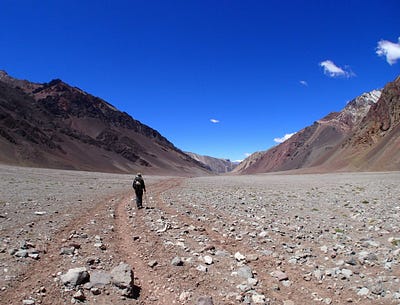


We celebrated some more and then hopped onto the bus for the 3 hours drive (4 hours in this case as a GIANT landslide had decimated 17km of highway a few days earlier) back to Mendoza town where we checked back into our hotel, showered for ever and then went out on the town for beers, wine and giant steaks!

I learnt many lessons on this mountain, particularly about eating whenever possible despite having no appetite and ensuring my energy levels are always topped up, dealing with small issues before they turn into giant problems including simplifying my gear and minimizing distractions and most importantly, how to stop getting frostbite on my face whilst still being able to breathe.
Despite Aconcagua not being technical, it is not an ‘easy mountain’ as some people say. It was an amazing 2 weeks with extreme highs and horrible lows where I met some amazing people who will be friends for life.
Maybe I wasn’t quitting mountaineering just yet.
My public Facebook album of this expedition can be found here

